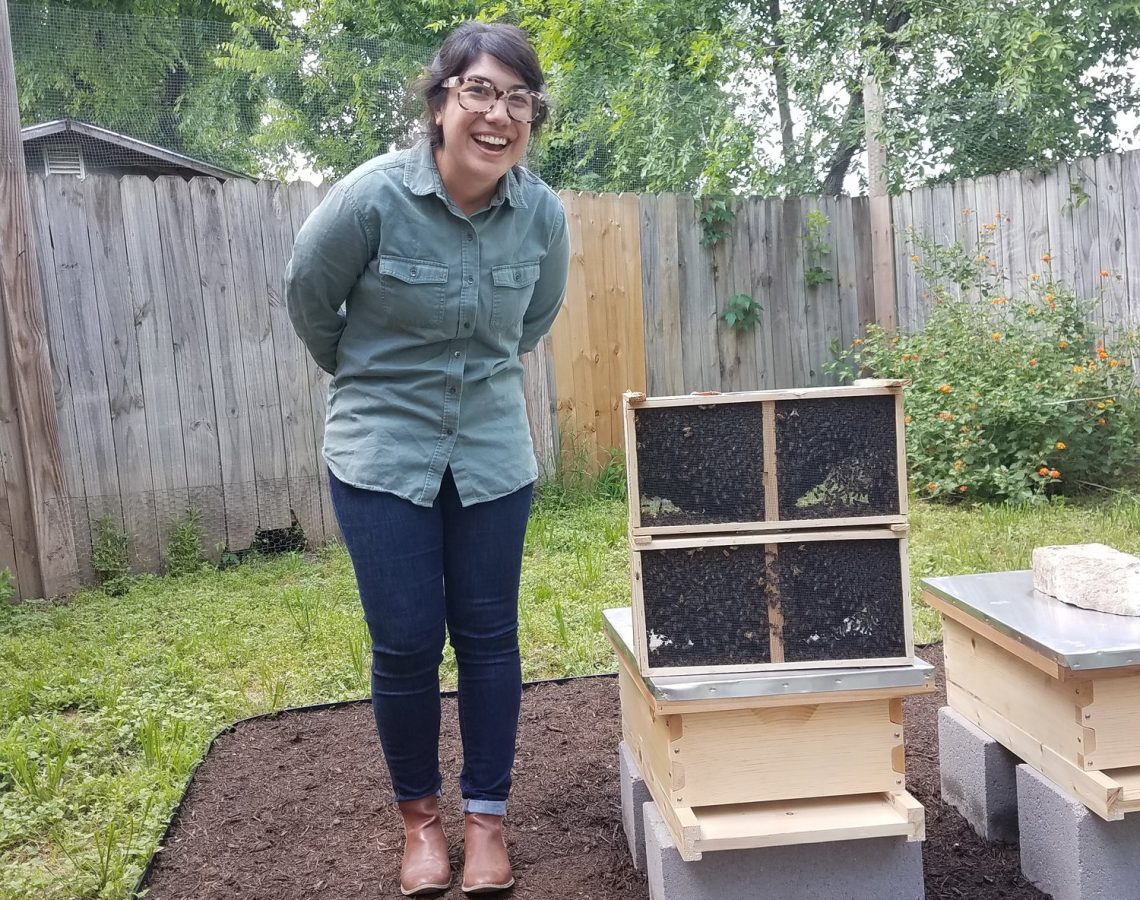Will Work For Bees

You’ve got your equipment, and decided on your hive type, and now you just need bees! Believe it or not, many beekeepers breed bees just to help supply hobbyists with the opportunity to become beekeepers! Today I will lay out your options, and the pros and cons of each. Look at how excited Jackie is above about her two new packages of bees!
A PACKAGE OF BEES
A package of bees is a screened box that includes approximately 10,000 worker bees (give or take a few). Think of a package as a sort of swarm in a box. Beekeepers go to their strongest hives and literally shake bees from those hives into these boxes. They are sold in three pound increments, and each is given a newly mated queen. The queen will come in a separate tiny screened box called a queen cage. Because these bees come from many different hives with existing queens, they need some time to accept the newly-provided queen. This queen cage allows them access to her pheromones but provide her protection from these bees that would otherwise be inclined to kill her. Once you buy a package, they need to be installed into your hives as soon as possible, and no more than a day or two after you pick them up. You install a package by shaking the bees into your own hive woodenware and hanging your queen between two frames.
A NUC HIVE
A nucleus hive, or “nuc”, is a tiny version of a regular hive. You generally receive five frames of various stages of brood (developing bees), worker bees, a laying queen, and honey in a cardboard or plastic box. The beekeeper has made a split, or increase, off of their existing hives by pulling four frames of brood and one frame of honey and given this mini hive a new queen (using the same queen cage method described above). You install this into your own woodenware by simply lifting the frames out of the nuc box and placing them into your own hive bodies. Presuming your nuc box is ventilated and has an entrance, you don’t need to install the nuc into your hive right away. Place the nuc in the same spot as your hive and open the entrance, allowing the bees to start to orient themselves to their new home and begin foraging for food. Particularly if the bees are on a nectar flow, they may run out of space in the nuc very quickly, so be sure to install within a week of pickup. Check out our video below to find out how to install your new nuc.
SO, WHICH SHOULD I BUY?
Theoretically, a nuc hive puts you a bit ahead of the game. The nuc already has five drawn out frames of brood and stored honey, whereas the bees in the package are starting from scratch. That being said, I generally encourage brand new beekeepers to start hives off of packages at least once. Watching a box of bees make a home of out nothing is quite a sight. Also, nucs tend to be much more expensive. Finally, keep in mind if you buy a nuc that you have to ensure you have the right size hive body to fit the nuc frames. Almost all beekeepers sell deep size nucs, though a few sell medium size nucs. Here at Two Hives we run all medium brood boxes in our hives because I like the interchangeability of only running one hive body size.
“FREE BEES”
There is a third option, and the one that sounds the most appealing. “free bees” entails catching a swarm or doing a live hive removal of a wild hive. However, I don’t recommend these options for beginners for a few reasons. First, you aren’t guaranteed to come across either, and if you have your heart set on keeping bees you are better served ordering bees to guarantee you can start a hive. Second, while swarm catching is pretty simple, it does require a basic understanding of how a colony functions and you will be much better at swarm catching after a year of tending bees under your belt. A lot can go wrong very quickly with hive removals, so I’d leave this one to the professionals for now.
A FEW FINAL TIPS
Finally, unless you live in Europe, Asia, or Africa, honey bees are not native to your area. Therefore, I always recommend folks try to find a queen bee breeder in your region to ensure the bees are adapted to your climate. Second, I also generally recommend you research your options carefully to learn a bit more about what practices they employ, such as what treatments or antibiotics they use, and ensure they select for hygienic behavior and gentle temperament. I also get a lot of questions about what sub-species to look for, such as Italian or Russian honey bees. Rather than looking for these particular-sub species, I’d focus on the breeder’s practices and ability to select for ideal traits.
We’ve got your beekeeping equipment needs covered in our shop! Contact us to make sure we’ve got what you need in stock.
Happy bee-tending!!



Do you come to properties and install hives for the purpose of Ag exemptions? If so, when would you install a new apiary? What is the minimum number of hives?
Alex Carrillo
Hello, Alex. I’ll send you information on our maintenance program.